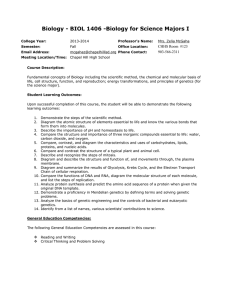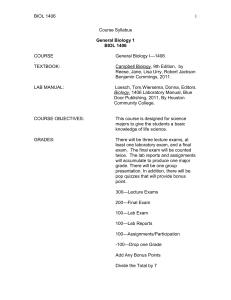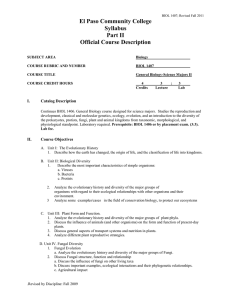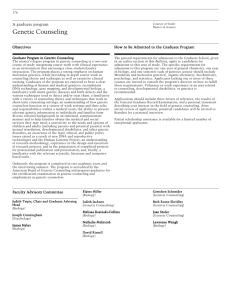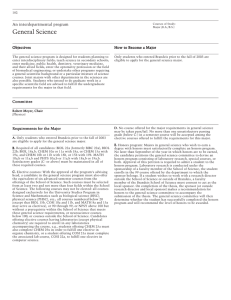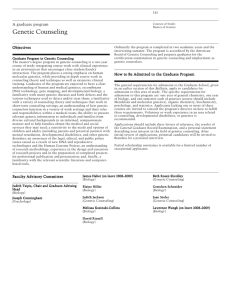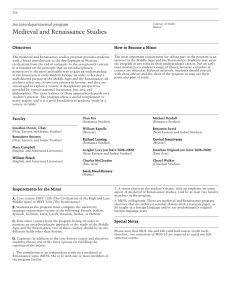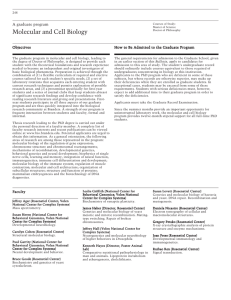El Paso Community College Syllabus Part II Official Course Description
advertisement
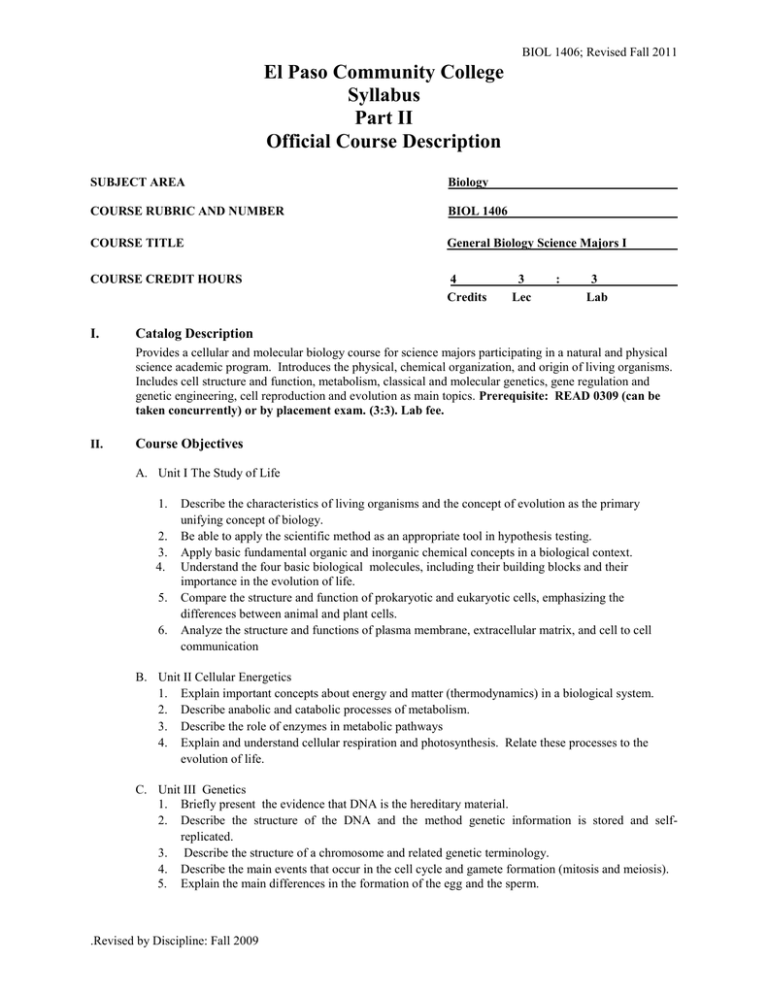
BIOL 1406; Revised Fall 2011 El Paso Community College Syllabus Part II Official Course Description SUBJECT AREA Biology COURSE RUBRIC AND NUMBER BIOL 1406 COURSE TITLE General Biology Science Majors I COURSE CREDIT HOURS 4 Credits I. 3 Lec : 3 Lab Catalog Description Provides a cellular and molecular biology course for science majors participating in a natural and physical science academic program. Introduces the physical, chemical organization, and origin of living organisms. Includes cell structure and function, metabolism, classical and molecular genetics, gene regulation and genetic engineering, cell reproduction and evolution as main topics. Prerequisite: READ 0309 (can be taken concurrently) or by placement exam. (3:3). Lab fee. II. Course Objectives A. Unit I The Study of Life 1. 2. 3. 4. 5. 6. Describe the characteristics of living organisms and the concept of evolution as the primary unifying concept of biology. Be able to apply the scientific method as an appropriate tool in hypothesis testing. Apply basic fundamental organic and inorganic chemical concepts in a biological context. Understand the four basic biological molecules, including their building blocks and their importance in the evolution of life. Compare the structure and function of prokaryotic and eukaryotic cells, emphasizing the differences between animal and plant cells. Analyze the structure and functions of plasma membrane, extracellular matrix, and cell to cell communication B. Unit II Cellular Energetics 1. Explain important concepts about energy and matter (thermodynamics) in a biological system. 2. Describe anabolic and catabolic processes of metabolism. 3. Describe the role of enzymes in metabolic pathways 4. Explain and understand cellular respiration and photosynthesis. Relate these processes to the evolution of life. C. Unit III Genetics 1. Briefly present the evidence that DNA is the hereditary material. 2. Describe the structure of the DNA and the method genetic information is stored and selfreplicated. 3. Describe the structure of a chromosome and related genetic terminology. 4. Describe the main events that occur in the cell cycle and gamete formation (mitosis and meiosis). 5. Explain the main differences in the formation of the egg and the sperm. .Revised by Discipline: Fall 2009 6. BIOL 1406; Revised Fall 2011 Understand the principles of Mendelian Genetics. Apply these principles to human situations, and analyze other forms of gene interactions such as sex-linkage, polygenic inheritance, codominance, epistasis and pleitropy D. Unit IV Molecular Genetics 1. Understand the central dogma of molecular genetics. Explain the main events during DNA transcription and translation. 2. Explain how current techniques are implemented in genetic engineering, biomedical research, medical applications, bioremediation, and industry. E. Unit V Evolution 1. Analyze the theory of evolution by natural selection. 2. Discuss the different types of evidence that support the Theory of Evolution. III. Evaluation A. Pre-assessment NOT required B. Post-Assessment 1. Lecture (75% of total grade); The type and number of exams will be determined by the instructor. A minimum of 5 written lecture exams are recommended. The type of exams can be multiple choice, true-false, etc., and its very desirable to include a section to evaluate the student’s written expression (objective/essay combination). Take- home exams are not recommended for this course. No exam will be dropped in calculating the final grade. All students are required to take the final exam. 2. C. Laboratory (25% of total grade), 3-4 grades based on practicum’s, group activities, presentations. The evaluation methods, frequency and individual weight of each assessment method is to be determined by the instructor. Grading Scale: 90 –100 80 –89 70 –79 60 –69 Below 60 IV. =A =B =C =D =F Disability Statement (American with/Disabilities Act [ADA]) EPCC offers a variety of services to persons with documented sensory, mental, physical, or temporary disabling conditions to promote success in classes. If you have a disability and believe you may need services, you are encouraged to contact the Center for Students with Disabilities to discuss your needs with a counselor. All discussions and documentation are kept confidential. Offices located: VV Rm C-112 (831-2426); TM Rm 1400 (831-5808); RG Rm B-201 (831-4198); NWC Rm M-54 (831-8815); and MDP Rm A-125 (831-7024) V. 6 Drop Rule Students who began attending Texas public institutions of higher education for the first time during the Fall 2007 semester or later are subject to a 6-Drop limit for all undergraduate classes. Developmental, ESL, Dual Credit and Early College High School classes are exempt from this rule. All students should consult with their instructor before dropping a class. Academic assistance is available. Students are encouraged to see Counseling Services if dropping because exemptions may apply. Refer to the EPCC catalog and website for additional information. .Revised by Discipline: Fall 2009
